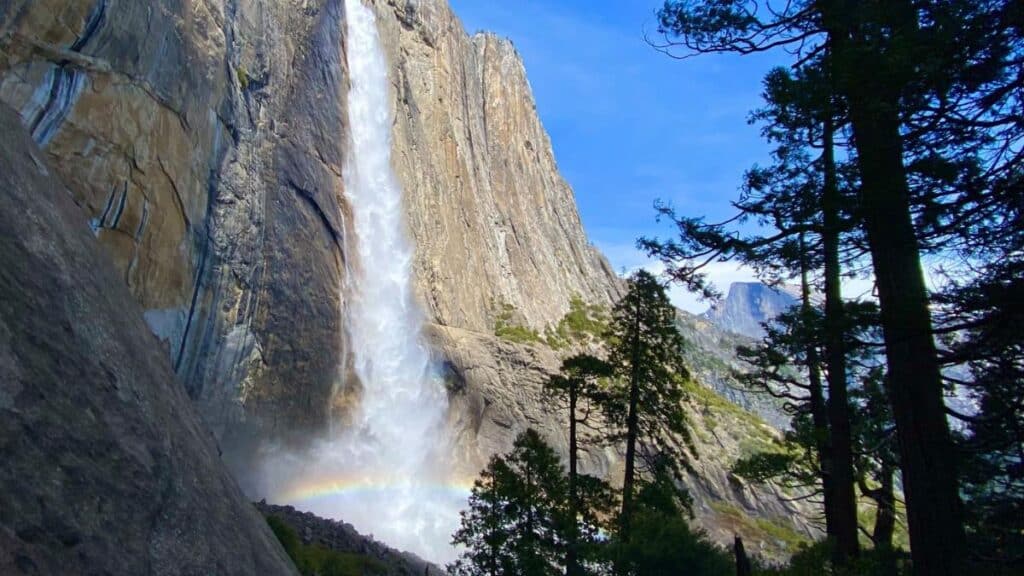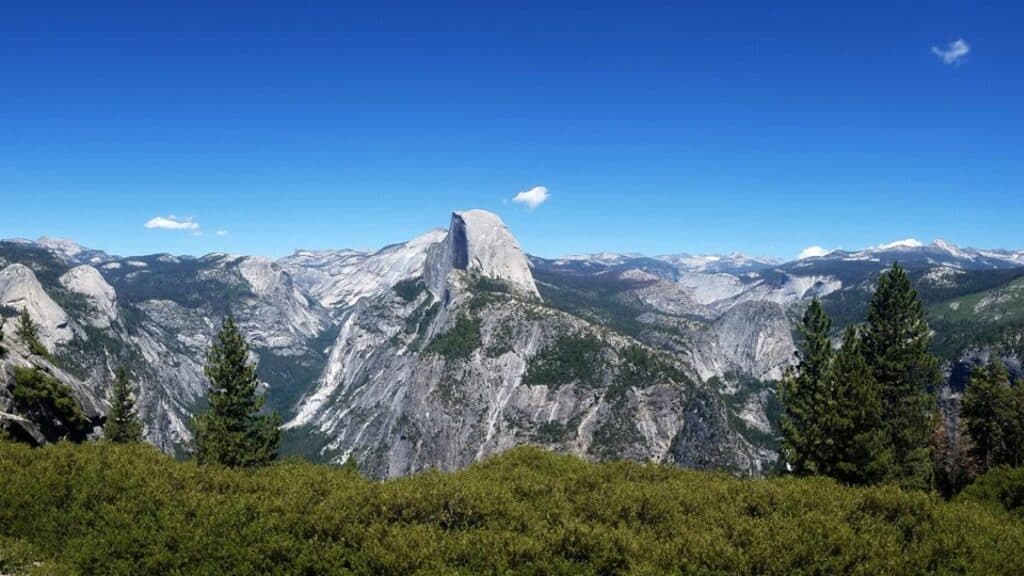Are you looking for the best things to do in Yosemite National Park for your next outdoor adventure?
Yosemite is one of the most picturesque parks in America. Within its boundaries, there are countless natural attractions that, by themselves, are worth the trip.
To see the best Yosemite has to offer, it can take several visits, so we created this list of the must-see destinations in the park, so you can create an itinerary of a lifetime.
Whether you plan on packing a hiking backpack to travel to Yosemite for a day trip or a long weekend stay at a cabin inside the park, you won’t have to miss a single highlight.
Now prepare yourself to learn about these breathtaking and jaw-dropping waterfalls, giant trees, and mountain peaks that are sure to make you fall in love with Yosemite.
Top Things to Do in Yosemite National Park
Yosemite National Park is a massive 1,169 square miles of granite domes, gushing waterfalls, and redwood forests that are spread throughout the park.
The majority of the park’s top sights and attractions are located in the centrally located Yosemite Valley in Mariposa County, but there is also a lot to see off Tioga Road.
It’s very important to plan your trip in advance so you can spend less time driving and more time checking out the top things to do in Yosemite National Park.
This national park’s highlights range from the impressive Yosemite Falls to Half Dome’s massive granite face, which towers over the park.
If you are short on time, you might consider taking a Park Ranger-led Yosemite Valley Floor Tour before rushing off to catch a flight at one of the airports close to Yosemite.
Spend some time picking the top places you want to visit in the park from this list, and only pick the options and the unique things about Yosemite that you are excited to experience.
Yosemite Falls

This majestic waterfall towers 2425 feet above the Yosemite Valley and is one of the top attractions in the park.
To see the falls in all of their glory, you will want to visit during the spring when the snow starts to melt in the upper elevations, causing a torrent of water to flow down the cliffs to the Merced River.
While Yosemite Falls can be seen from many vantage points in the heart of the park, it is best viewed from along sections of the Yosemite Falls Trail which starts near the Yosemite Valley Lodge and zig-zags 3245 feet up from the valley floor.
For those looking for a more relaxed way to experience the falls, visitors can take in the views looking up at these massive falls from the Lower Yosemite Falls Vista Point.
For a special treat, get up early and head to Cooks meadow in the middle of the valley, where you can see the mirror reflection of Yosemite Falls in the still Merced River.
Tip: Before heading to Cooks Meadow to take in the views of Yosemite Falls, make sure to stop by the Ansel Adams Gallery to see some of this master photographer’s work.
Tunnel View

This majestic viewpoint is the perfect introduction to Yosemite as the vantage point offers a look at most of the main attractions along the 7-mile-long valley.
For those entering the south entrance of the park, this will be one of the first things to see in Yosemite after visiting Wawona Grove.
This viewpoint gets its name from the 4233-foot-long tunnel carved through the mountain connecting the Wawona road with the Yosemite Valley.
From this viewpoint, you get a spectacular view of multiple waterfalls pouring into the valley from Bridal Veil Falls and Horsetail Falls, along with the mist from upper Yosemite Falls.
This is also an opportunity to see four of Yosemite’s most famous granite peaks, including Half Dome, Clouds Rest, Sentinel Rock, and El Capitan, in one place.
It’s best to visit Tunnel View in the morning on your way into the valley to prevent having to deal with the stress of finding a parking spot.
Glacier Point
If one of your top priorities is to see Half Dome in all of its splendor, then a visit to Glacier Point should be at the top of your itinerary.
After making the 17-mile drive up Glacier Point Road from Wawona Rd, you will be greeted with a jaw-dropping panoramic view of Yosemite Valley.
The trail from the parking lot will lead you to a viewing area that sits on the 3418-foot shear cliff that towers over the valley floor and will certainly make your toes tingle.
Don’t worry, there is a short wall and a guard rail to keep visitors safe while they stare through the lens of their camera for a few shots.
The road to this majestic view is only open after the snowpack melts to just before the first storm of the year (mid to late April till the middle of November), so you will need to time your visit accordingly.
If you miss this window or are looking for a quad-burning but rewarding challenge, you can hike up to the top of Glacier Point on the Four Mile Trail.
Another option is to take a four-hour Ranger-led tour to Glacier Point, where you will learn about the park’s natural history while seeing several of Yosmite’s highlights along the way.
Half Dome

There are several ways to enjoy this iconic granite monolith, and each option offers a different vantage point to take in this natural wonder.
For most Yosemite visitors, the easiest and most relaxing way to experience Half Dome is from the window of your room at the Ahwahnee Hotel or from most parts of Cook’s Meadow.
Anyone lucky enough to secure a permit through the Yosemite lottery system will get a chance to hike to the top and take in the views along this challenging round-trip hike that requires the use of cables.
For the brave few that are into scaling massive rock slabs, Half Dome is a popular destination for serious rock climbers who want to really test their skills.
It is safe to say that almost any visit to Yosemite Valley will include views of Half Dome, as it is the backdrop of many of the park’s top views and attractions.
El Capitan

This massive rock formation jets right out of the western side of the valley and is the first rock face visitors see when driving along Southside Drive.
The best views of “El Cap” is from El Capitan Meadow, where you can stand at its base and truly appreciate the scale of this massive rock.
This is also a great location for a picnic, with one of the most dramatic backdrops in the world.
If Yosemite is considered the rock climbing capital of the world, the El Capitan is its epicenter.
This massive course-grained granite slab has also been made extra famous, as it was featured prominently in several climbing documentaries.
Make sure to bring your binoculars, as one of the most fun things to do in Yosemite is to try and spot the climbers making their way up El Capitan’s shear face.
Mirror Lake

Mirror Lake is a small mountain lake situated inside Tenaya Canyon and at the base of the meadow.
From the shore, you can see the spectacular reflection of Half Dome and the surrounding peaks when the water is calm.
It’s imperative to arrive early if you want to experience this natural attraction in all of its splendor.
It can get really busy as the day progresses, and many visitors ruin the still water by swimming and throwing rocks.
Another option is to come after the sun starts to dip to enjoy this incredibly serene setting with only a few other visitors.
To visit Mirror Lake, you can either drive directly to the parking lot or take the 5-mile round trip hike along the Mirror Lake Loop Trail from the park shuttle stop on Happy Isle Loop Rd.
The trail goes farther up the canyon and gets away from the crowded lake for a chance to take a dip in a few semi-secret spots along Tenaya Creek.
Local Tip: For anyone up for a little extra hiking, walk the extra .7 miles to the John Muir Trail to visit Vernal Falls.
Mariposa Grove
If you have ever dreamed of standing at the foot of a giant, this is your chance.
The Mariposa Grove is home to over 500 mature Giant Sequoias, the largest trees in the world.
The giant Sequoia tree that harbors the most attention is the Grizzly Giant, the second biggest in the grove and the oldest at an estimated 2700 years old.
For visitors coming from Southern California destinations, this will be the first place you will want to stop after entering Yosemite, as the parking lot is less than a quarter mile away.
From the parking lot, visitors can take the Mariposa shuttle, but it only runs from April 1st to the end of November.
Outside of this time frame, anyone who wants to see this spectacular grove of Sequoias will have to make the trek along the 3.7-mile Washburn Trail, which gains over 500 feet in elevation.
Once visitors arrive at the base of the grove, there are several manicured trails, including a Sequoia you can walk through.
Visit this fantastic grove along with all the other amazing attractions in Yosemite instead of making a second trip to Sequoia national park.
Tuolumne Grove
Anyone planning to come to the Park through the Tioga Pass or the Big Oak Flat entrance will offer a semi-easy opportunity to experience the massive Sequoias.
This grove is home to 24 mature Sequoias that are only accessible by hiking down the Tuolumne Grove Trail, which descends 623 feet of elevation and is 2.7 miles round trip.
This means you will want to bring some water as the hike back up is a leg burner.
The trees in this grove are absolutely massive, but visitors should be warned that there are not as many, and they are not as large as some of the Giant Sequoias in the Mariposa Grove.
This is still a very special destination in the park, and any chance to experience these giant trees is worthy of a detour.
The Tuolumne Grove does get very busy by midday, and it is highly recommended to kick off your day early at this grove to avoid it feeling like you are at an amusement park.
Horsetail Falls
This unique waterfall gets its name from its thin, whispering stream of water that flows unencumbered like a horse’s mane.
This waterfall is often overlooked, as visitors are naturally drawn to the more powerful flow from Bridal Veil and Yosemite Falls.
This all changes for a few magical moments in February when the waterfall glows like magma as the sunset penetrates through the streaming water.
This unique natural phenomenon is now very popular, and reservations are required through the National Park Service.
The best time to see this waterfall at its strongest flow is during the spring, and the best viewpoints are from the west side of the El Capitan picnic area.
Bridalveil Falls
This is, without a doubt, one of the most majestic natural attractions in the park, as visitors can get up close enough to feel the massive amounts of mist from this large waterfall.
While this waterfall is not as big as Yosemite Falls, it is just as loved by park visitors who get to reach out a feel its cold water.
This is extra nice on days in the park when the temperature jumps up into the 90s during the summer.
Bridal Veil Falls is one of the only waterfalls in the park that commonly flows year-round, but the mist can create some dangerous icy conditions during the colder winter days.
This attraction is relatively easy to experience for most visitors, including kids and seniors, as the walk to its base is less than a half mile with very minimal elevation gain.
This is one of the top things to do at Yosemite, and it is also a great place to find a quiet spot along Bridal Veil Creek to enjoy some relaxation and enjoy a picnic.
Tioga Pass Road
The Tioga Pass Road is the gateway to Yosemite and is the fastest way to connect destinations like Convict Lake and Mammoth Lakes with the popular destinations in the park.
Along the way, there are several beautiful viewpoints and scenic mountain lakes that make this drive a destination of its own.
The Tuolumne Pass starts near the small town of Lee Vining off Highway 395 and extends to the Tioga Pass park entrance.
After enjoying the scenery along the way, you can visit Tuolumne Meadows, which is a must-see in Yosemite and is often overlooked by visitors.
For hiking enthusiasts, this is the best destination in Yosemite for amazing trails that are seldom busy, as this area of the park is far from the most popular activities in Yosemite.
This includes the Clouds Rest Trail, which rewards those that complete the long trek with one of the top vantage points of the entire Yosemite Valley.
Hetch Hetchy Valley
After spending a few days with the crowds inside the Yosemite Valley, the Hetch Hetchy Valley offers the perfect escape.
In 1923 the Tuolumne River was dammed in the entry to the valley, and the Hetch Hetchy reservoir was formed.
This area in the north of Yosemite only receives less than 1% of the total visitors to this national park and is a hidden gem when the valley is jammed up.
Visitors will be treated to multiple gorgeous waterfalls, including the 1400-foot-tall Wapama Falls, which commonly flows year-round.
There are several great hiking trails along the shores with great views of the granite walls surrounding the valley.
If you are short on time, you may want to save the Hetch Hetchy Valley for another trip unless the crowds get too unbearable.
Hetch Hetchy should be one of the top things to do in Yosemite Valley for those that want to carve out a private slice of heaven away from the tour buses and lines at the visitors center.
Wrap-Up
Now that you know about all the top things to do in Yosemite National Park, take a moment to create an itinerary so you don’t miss a single one of these incredible natural wonders.
Grab your hiking shoes, book your accommodation, pack your bags for Yosemite, and get prepared to experience one of America’s greatest treasures.
